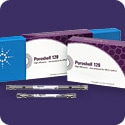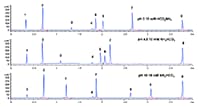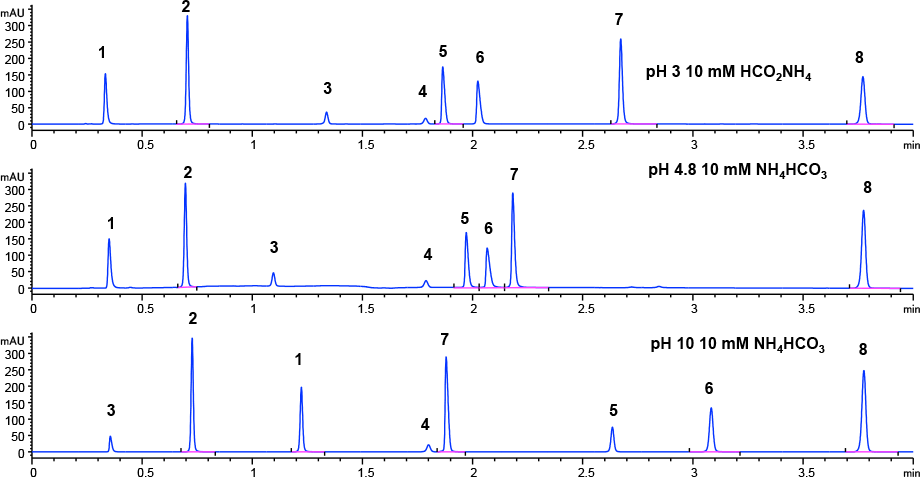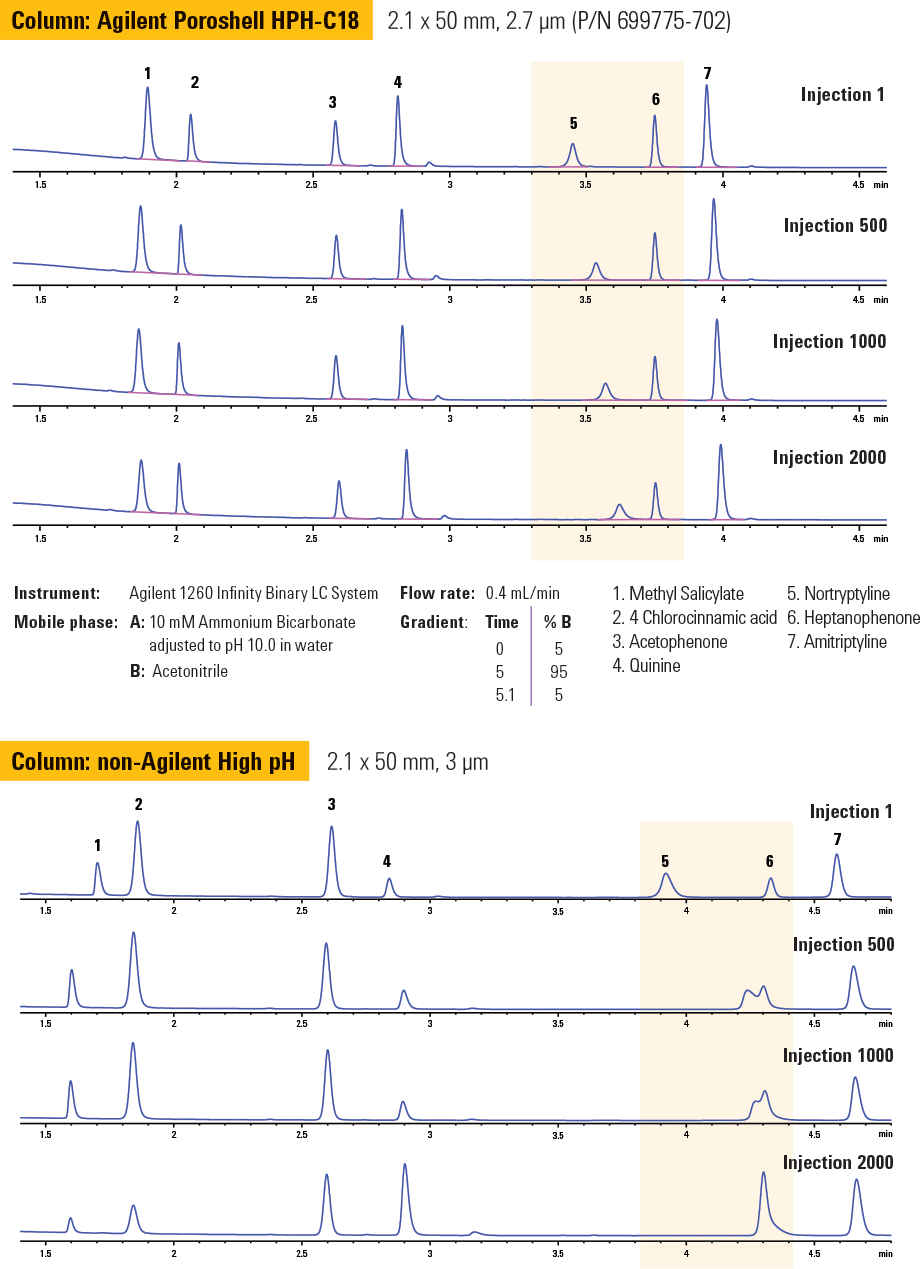Access Agilent eNewsletter, July 2014
>> Update My Profile | Subscribe to Access Agilent | Article Directory

Chromatographers no longer need to compromise when it comes to working with high pH conditions
By Jason Link
Agilent Small Molecules HPLC Columns Product Manager
A number of challenges make HPLC method development more confusing than ever. One example involves the increasing number of companies that now have labs situated across the globe. These companies must be able to transfer methods seamlessly between their networks of labs, including contract labs in many cases. In order to maintain efficiency and accuracy on this scale, the requirement for a robust method is critical.
Keeping track of mobile phase pH for method optimization
A robust method demands an equally robust process for method development. A sound process is critical to maintaining long lasting, stable, and reliable methods. Common steps in method development include choosing the separation mode, column chemistry, and organic mobile phase. An often overlooked step is the adjustment of mobile phase pH, which can play a very important role in method development. Ionizable compounds, such as acids and bases, can have significant changes in retention and selectivity as the pH changes. Because it is so important to identify the best pH for method optimization, it is increasingly common to use a low, medium, and high pH analysis as standard practice during method development.
However, while the use of low, medium, and high pH analysis increases the likelihood of success in separating the analytes of interest, it comes with some challenges. As the majority of HPLC columns are built on a silica support, adopting a method that uses a medium or high pH can reduce column lifetime – especially when the pH is coupled with higher temperatures. Under these higher pH conditions, analyte retention can shift over time, causing unpredictable results and requiring more frequent column replacement. The end result is increased analysis costs for the method.
An underlying cause for retention shift is the destruction of the HPLC column at elevated pH conditions. Under these elevated pH conditions, the siloxane bonds in the silica support are hydrolyzed, resulting in dissolution of the silica. This results in retention shifts and poor overall quality chromatography.
 Enlarge
Enlarge
Figure 1. A separation at low, medium, and high pH in method development using an Agilent Poroshell 120 HPH column (solvent A, buffer; solvent B, acetonitrile).
 Enlarge
Enlarge
Figure 2. 2000 injections of a separation mixture containing acidic, basic, and neutral compounds were preformed under extreme pH 10 conditions on an Agilent Poroshell HPH-C18 and a non-Agilent high pH column.
New Poroshell technologies prolong column lifetime under high pH conditions
New column technologies are now able to combat silica dissolution and the resultant retention shifts. As mentioned earlier, most HPLC columns are silica based, which limits the choices for robust columns under elevated pH conditions. In addition, as more and more chromatographers migrate to the superficially porous technologies for Fast LC, they are left with no choice but to choose a silica-based column.
Agilent has addressed the issue of silica dissolution under elevated pH conditions with the introduction of Poroshell HPH-C18 and HPH-C8 technologies. Thanks to a proprietary process that organically modifies the silica surface; the chromatographic support remains stable even under high pH. Furthermore, by adding this technology to the Agilent Poroshell 120 family, you can continue to use Poroshell 120 columns for all Fast LC method development needs, regardless of the mobile phase pH.
Figure 1 shows how this chemistry offers additional flexibility in your method development. A method with low, medium, and high pH was used to separate a mix of acids, bases, and neutral compounds. As the best resolution for all compounds was obtained under the higher pH conditions, this would be the best choice for the method in the future. However, problems can be encountered if the column has silica-based supports. Since the Agilent Poroshell HPH-C18 has organically modified silica support, the column can be employed at elevated pH with far less impact on column lifetime. In Figure 2 we demonstrate the effects of 2000 injections of a mixture of acids, bases, and neutrals under elevated pH and temperature on an Agilent HPH-C18 and a non-Agilent high pH column.
Beyond pH: Flexibility in method development through phase chemistry
The increased retention stability at elevated pH levels provides chromatographers with access to the added benefits of the expansive Agilent Poroshell 120 family. These include decreased separation times and increased throughput, with minimal impact on backpressure. The new Poroshell HPH chemistries help to solve a longstanding problem in method development by improving column lifetime under elevated temperature and pH conditions, minimizing downtime in the laboratory and saving time and money.
The Agilent Poroshell 120 range delivers sub-2 µm performance with all existing LCs. Stable to 600 bar, Poroshell 120 is excellent for fast UHPLC analyses, and can accelerate your older, traditional 5-µm method for a four to five times reduction in analysis time. With a family of ten phases closely aligned with ZORBAX chemistries, method development and transfer is flexible and easy. Agilent offers many resources and examples on the use of the Poroshell 120 column, so take this opportunity to explore the Application Notes by industry. Then see for yourself why the Agilent Poroshell 120 family of columns with modified silica surface outlasts other columns under the toughest of conditions.
>> Update My Profile | Subscribe to Access Agilent | Article Directory
Figure 1.
Poroshell HPH at pH 10, 4.8 and 3 4.6x50 mm
- Procainamide
- Caffeine
- Acetyl Salicylic Acid
- Hexanophenone Deg.
- Dipyrimadole
- Diltiazem
- Diflunisal
- Hexanophenone

A separation at low, medium, and high pH in method development using an Agilent Poroshell 120 HPH column (solvent A, buffer; solvent B, acetonitrile).
